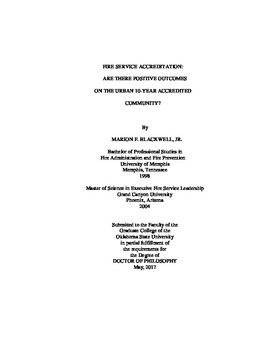| dc.contributor.advisor | Neal, Dave M. | |
| dc.contributor.author | Blackwell, Marion Fred Jr. | |
| dc.date.accessioned | 2018-03-13T18:14:58Z | |
| dc.date.available | 2018-03-13T18:14:58Z | |
| dc.date.issued | 2017-05 | |
| dc.identifier.uri | https://hdl.handle.net/11244/54488 | |
| dc.description.abstract | Does Fire Service Accreditation have a positive outcome on the community? No one seems to know. My research discovered no academic research on fire service accreditation outcomes on the community. As far as that is concerned, there is no academic research on community outcomes for any publicly funded organization that can pursue accreditation. It seems that scholars are concerned more with measuring and improving the organization's outputs and not how organizational outputs affect community outcomes. Case in point, law enforcement accreditation measures case clearance rates, but fails to determine if the case clearance rates correlate to a reduction in crime. Organizations spend exorbitant amount of resources to obtain and maintain accreditation. So how does the community benefit? | |
| dc.description.abstract | This research focused on four specific fire suppression variables to determine if accreditation had a positive outcome on the urban 10-year accredited community: casualties, property loss, ISO rating, and insurance premiums. These variables were selected due to the economic impact the community felt with a decrease or increase in the variable. The database maintained by The Center for Public Safety Excellence, which serves as the fire service accreditation agency, provided the accredited sample. The National Fire Incident Reporting System Census maintained by the United States Fire Administration helped to provide the non-accredited sample as well as supplying the casualty and property loss data. Individual departments or ISO Community Hazard Mitigation supplied ISO ratings. National insurance companies located within the communities in which the fire service provided services contributed the insurance premium information utilized. | |
| dc.description.abstract | The results of the data analysis indicated a statistical significance in casualties and ISO Ratings. The inference is the urban 10-year accredited departments had a statistically lower number of injuries and deaths along with a reduction in their ISO rating. There was a practical significance in all variables in that the urban 10-year accredited departments had overall lower casualties, property loss, ISO rating and insurance premiums. Based on the observations of the data, an inference supports the hypothesis that an accredited fire service agency provides positive fire suppression outcomes in the urban 10-year accredited community. | |
| dc.format | application/pdf | |
| dc.language | en_US | |
| dc.rights | Copyright is held by the author who has granted the Oklahoma State University Library the non-exclusive right to share this material in its institutional repository. Contact Digital Library Services at lib-dls@okstate.edu or 405-744-9161 for the permission policy on the use, reproduction or distribution of this material. | |
| dc.title | Fire service accreditation: Are there positives outcomes on the urban 10-year accredited community? | |
| dc.contributor.committeeMember | Clark, Burton A. | |
| dc.contributor.committeeMember | Chang, Hsien-Ho Ray | |
| dc.contributor.committeeMember | Wang, Qingsheng | |
| osu.filename | Blackwell_okstate_0664D_15029.pdf | |
| osu.accesstype | Open Access | |
| dc.type.genre | Dissertation | |
| dc.type.material | Text | |
| thesis.degree.discipline | Fire and Emergency Management Administration | |
| thesis.degree.grantor | Oklahoma State University | |
